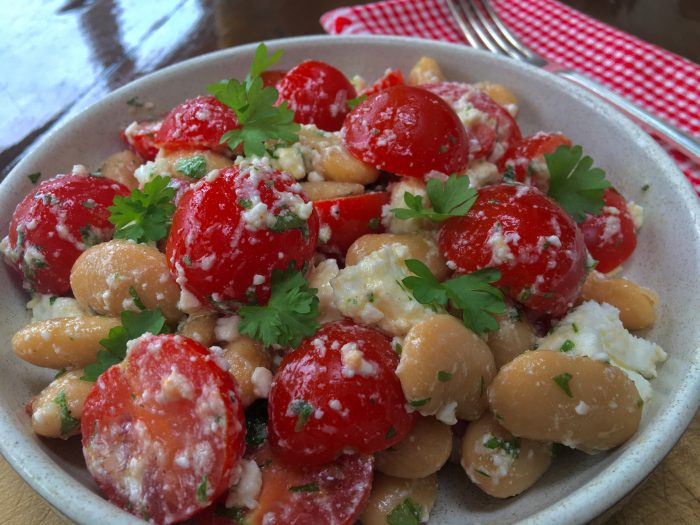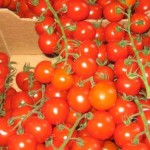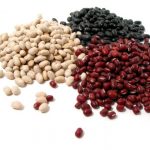Just as it is with a chunk of warm wholemeal bread? A delicious side with meat or fish? A lovely lunchbox filler? You decide ... this dish is so simple and fun for kids to make, and the colours are simply stunning.
Skills Check
Follow a recipe; follow food safety & hygiene rules; tidy away; use measuring jugs and spoons; use weighing scales; cut using bridge/claw technique safely; snip herbs with scissors; use a tin opener safely; use a colander.
Equipment
Large bowl, small bowl, weighing scales, measuring spoons, tin opener, chopping board, knife, measuring jug, colander/sieve, scissors, spoon.
Allergens (Please note the allergens listed are indicative only. Allergens vary depending on brand; check the labels on the products you use)
Milk | Sulphites
Ingredients (serves 4):
- 454 g tin of Butter Beans, in water
- 300 g cherry tomatoes, halved
- 160 g reduced fat feta cheese, crumbled
- 1 shallot, finely chopped
- 1 tbsp parsley, snipped with scissors
- 2 tbsp olive oil
- 1 tbsp red wine vinegar
Method
- Mix the olive oil, red wine vinegar and shallots in a large bowl.
- Drain the beans and add them to the bowl, along with the crumbled feta, tomatoes and parsley.
- Mix well, and serve.

 So thinking about Butter Bean, Tomato & Feta Salad ...
So thinking about Butter Bean, Tomato & Feta Salad ...
Butter Beans are legumes, and like other legumes (peas & lentils) they are packed with protein and fibre. They are also low in calories and fat, and are a good source of vitamins and minerals.
Tomatoes are really good for us containing a wide range of vitamins and minerals.
Feta cheese is a source of protein and calcium. Although lower in fat than some cheeses it should be used sparingly due to its very high salt content.
Nutritional Information
| Energy | 977kJ / 234kcal | 12% | |
| Med | Fat | 10.0g | 14% |
| Low | Saturates | 3.3g | 17% |
| Low | Sugars | 4.5g | 5% |
| Med | Salt | 0.8 | 14% |
per 237g serving
% of an adult's reference intake
Typical values per 100g: Energy 412kJ / 99kcal
Notes
A traffic light system is used on nutrition labels to make it easier to see which foods and drinks are lower in calories, fat, sugar and salt. Try and choose more ‘greens’ and ‘ambers’ and fewer ‘reds’, and stick to smaller portions of ‘reds’.
Just because a recipe or a food has a red traffic light doesn’t mean you shouldn’t eat it. Understanding why a food or recipe might have a red light can be helpful. For example oily fish is high in total fat and so any recipe containing oily fish is likely to be ‘red’ for fat. But it is recommended that we eat oily fish at least once a week because the type of fat it contains is beneficial for our health.
% Reference Intakes are also shown. Reference Intakes are guidelines about the approximate amount of particular nutrients and energy required for a healthy diet (based on an average-sized woman doing an average amount of physical activity). Most children will require less than these Reference Intakes. The contribution of one serving of a food or drink to the Reference Intake for each nutrient is expressed as a percentage.



 So thinking about Butter Bean, Tomato & Feta Salad ...
So thinking about Butter Bean, Tomato & Feta Salad ...